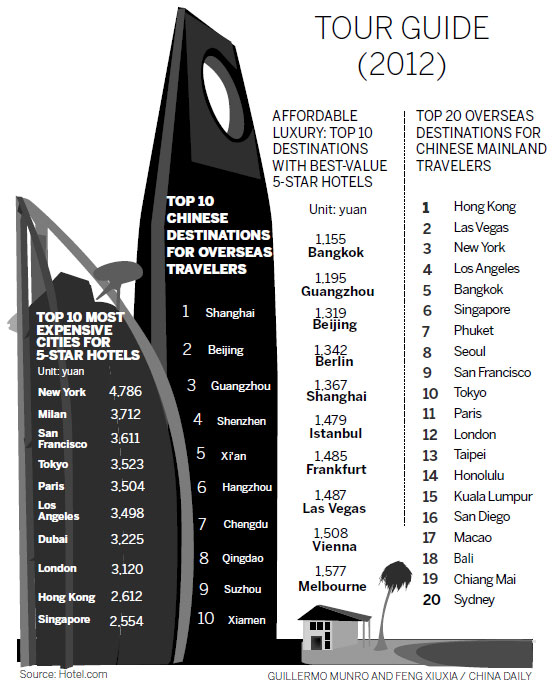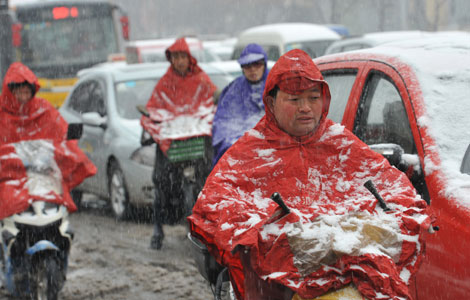Sanya tops the tourism stakes
Updated: 2013-04-22 07:14
By Wang Zhuoqiong (China Daily)
|
||||||||
|
Four Points by Sheraton in Sanya, South China's Hainan province. A recent survey covering prices paid in China by all travelers shows that the tourism market in the southern tropical city of Sanya will grow exponentially over the years in line with the local government plans to make it a global tropical island resort destination by 2020. Provided to China Daily |

Higher inflows to provide strong growth momentum for hotels this year
Sanya, a city in South China's Hainan province, continued to be highest paid tourism destination in China amongst all travelers, followed by Chengdu and Xi'an, according to a recent survey conducted by a leading online hotel booking system.
The Hotel.com's recent survey covering prices paid in China by all travelers shows that average hotel rates in 2012 remained more or less flat at 695 yuan ($112).
The survey noted that the tourism market in the southern tropical city of Sanya will grow exponentially over the years in line with the local government plans to make it a global tropical island resort destination by 2020. According to the survey, the city's daily hotel prices were the highest at an average rate of 1,165 yuan, despite a 15 percent decline over the previous year.
Lower demand from Chinese tourists was one of the main reasons why hotel rates in Sanya remained low last year, said Jessica Chuang, senior marketing manager, Greater China of Hotel.com Asia Pacific.
In 2012, nearly 11.02 million tourists visited Sanya, an 8 percent growth over 2011, while tourism revenues grew by 11 percent over 2011 to 19.2 billion yuan.
Two other popular destinations - Chengdu, home of the giant pandas in Sichuan province and Xi'an with its world-renowned Terracotta Warriors - saw slight decreases in tourist inflows.
Overseas travelers still prefer Beijing, Shanghai and Guangzhou as their first destinations when they visit China, said Chuang. Hotel owners in destinations like Lijiang city in Yunnan province have benefited due to strong demand from domestic and overseas travelers, she said.
Qingdao, the major seaport famous for its beer festival, saw an 18 percent decline in hotel rates to 653 yuan. Other double-digit fallers included Ningbo and Kunming, making them the destinations where travelers paid the lowest average rates.
Amongst the stronger performers were Dongguan, home to the world's largest shopping mall, up 18 percent to 703 yuan and Quanzhou up 15 percent to 617 yuan. Hotel rates in Beijing rose 6 percent to 709 yuan, while the neighboring city of Tianjin recorded a 1 percent increase to 621 yuan.
The new 72-hour visa policy for foreign visitors, which came into effect on Jan 1, is likely to stimulate more travel numbers, which in turn will impact prices in the future, considering that many of the leading international hotel companies are planning major expansion in China.
Five star hotels in China are still not pricey when compared to other global peers, the survey said. According to the average prices paid in yuan for hotel rooms across different star ratings in the world, the average daily room rents in Guangzhou's five-star hotels is 1,195 yuan, while in Beijing it was around 1,319 yuan. Shanghai was only slightly higher at 1,367 yuan. Among these cities, the biggest decline in hotel rates was seen in Guangzhou, with prices falling by nearly 26 percent.
Most of the domestic travelers preferred to stay in China-based hotels with an average daily rate of 655 yuan, the report said.
The number of inbound travelers is expected to see an annual growth of about 10 percent between 2011 and 2015, Wu Wenxue, a senior official with China National Tourism Administration told Xinhua News Agency. He said that by 2015 inbound travelers to China would touch 3.3 billion, with travel spending accounting for 10 percent of the total residential consumption, and creating strong demand for theme, resort and economy hotels.
However, the growing number of visitors to domestic destinations does not necessarily mean that there has been a similar increase in the tourist satisfaction levels.
Earlier this month, the China Tourism Academy published a report on Chinese tourist satisfaction index for the first quarter of the year, which showed a sharp drop in satisfaction levels among inbound travelers.
The report found that most of the complaints are largely due to the deteriorating air quality such as continuous haze and sandstorm and the water quality in many destinations.
Among the respondents, foreign travelers have lower satisfaction than Chinese tourists on the air quality. In addition, prices at restaurants, tourism products and public services have also contributed to discontent among travelers, the report said.
wangzhuoqiong@chinadaily.com.cn

(China Daily 04/22/2013 page14)

 Obama celebrates young inventors at science fair
Obama celebrates young inventors at science fair
 Earth Day marked around the world
Earth Day marked around the world
 Volunteer team helping students find sense of normalcy
Volunteer team helping students find sense of normalcy
 Ethnic groups quick to join rescue efforts
Ethnic groups quick to join rescue efforts
 Earthquake leaves family shattered
Earthquake leaves family shattered
 Boston Marathon bombing suspect charged
Boston Marathon bombing suspect charged
 Chasing vestiges of the Great Wall
Chasing vestiges of the Great Wall
 Weekly Photos: April 15-21
Weekly Photos: April 15-21
Most Viewed
Editor's Picks

|

|

|

|

|

|
Today's Top News
Russia criticizes US reports on human rights
China 'aims to share its dream with world'
Chinese president appoints 5 new ambassadors
Nation's IPR suits see spike in 2012
H7N9 not spread between humans: WHO
Health new priority for quake zone
Sino-US shared interests emphasized
China, ROK criticize visits to shrine
US Weekly

|

|







